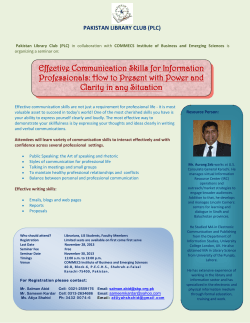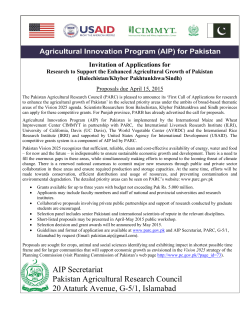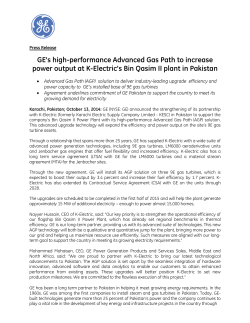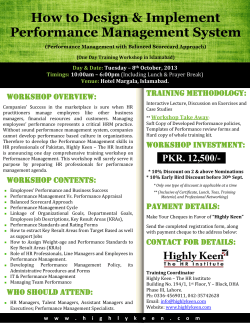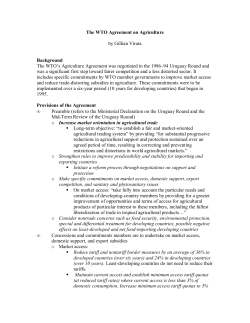
Pakistan: Agricultural Trade and Development Challenges Linda M. Young Political Science Dept.
Pakistan: Agricultural Trade and Development Challenges Linda M. Young Political Science Dept. Montana State University My Talk Tonight Will start with background • on me • on Pakistan Overview of the agricultural negotiations What Pakistan wants • how that surprised me Developmental challenges How Did I Get There? Agricultural trade economist • dealing with agricultural trade issues, NAFTA, then WTO for numerous years Member of the International Agricultural Trade Research Consortium • three commissioned papers on “export competition” Other work on food aid and state trading • “Experts” meeting in Rome, over Thanksgiving Pakistan new WTO unit Agricultural position for Hong Kong Ministerial November, 8 days, Islamabad 2x size of California 135 million people Islamabad 97% Muslim English common World’s 8th largest army Insert map here Remember … India wanted independence Idea of a separate Muslim state Muhammad Ali Jinnah, leader of the Muslim League • endorsed the Lahore resolution 1947 Britain gave independence to India and Pakistan • “Princely States” could join either one Muhammad Ali Jinnah Create a bifurcated Muslim state separated by 1,600 kms • including present day Bangladesh 6 million Hindus from Pakistan to India and 8 million Muslims vice-versa Conflict Over Kashmir Maharaja of Kashmir – Hindu • population mostly Muslim • Maharaja hesitated, Muslims revolted to join Pakistan • Maharaja gave loyalty to India, for military assistance – Indian troops occupied eastern portion of Kashmir, including Srinagar – western part under Pakistan Relationship with India tense ever since But, India should be Pakistan’s natural trading partner Sir Hari Singh Bahadur Maharaja of Kashmir Pakistan – Political Instability 1948: The revered Jinnah assassinated 1949-1970: Eleven administrations, sporadic martial law 1970: Bhutto, civil war 1971: East Pakistan split, independent Bangladesh, Bhutto rules 1976: Bhutto put to death, Zia in power 1988: Zia dies in airplane crash 1988-1996: Benezair Bhutto in and out of power 1997: Shariff and Tarar Note: President/Prime Minister change of powers 1999: Musharraf (Chief Executive, now President) Pakistan and the World Trade Organization Pakistan wants to develop technical capacity Negotiations complicated, technical, data intensive Many developing countries unhappy with URA Brazil: • leader of G-20 • making a difference • one factor is new technical capacity • example? Mário Jales ICONE Projects Coordinator OECD Producer Subsidy Equivalents (PSEs) by Country 80 73% 70 69% Percent 60 50 48% 45% 42% 42% 40 35% 30% 30 20% 20 10 16% 10% 9% 0 Australia Canada EU 1986-88 Japan US OECD 1997 Source: Agricultural Policies in OECD Countries, Organisation for Economic Co-operation and Development (OECD) Secretariat, 1998. Agricultural Markets 1970s: Scarcity and high prices 1980s: Abundance, high stocks and low prices • large government expenditures on agriculture Agriculture • • • • tariffs averaging 40-60% quotas on 30% of agricultural products history of domestic sub subsidies export subsidies used by many U.S. Agricultural Policies Loan rates and target prices • program crops • spurred production Export subsidies Tariffs and quotas U.S. Wheat Stocks and Prices Received Price Received 5 Stocks 200 175 4 150 125 3 100 Stocks 2 75 50 1 25 0 0 70/71 73/74 76/77 79/80 82/83 85/86 88/89 Crop Year Source: U.S. Dept. of Agriculture, 1995. Wheat: Background for 1995 Farm Legislation, AER-712, Economic Research Service, Washington, DC, Appendix Table 3. Million metric tons Dollars/bushel Price Received EU Self-Sufficiency Source: U.S. Department of Agriculture – Economic Research Service. 1999. The European Union’s Common Agricultural Policy: Pressures for Change. International Agriculture and Trade Report, Situation and Outlook Series, WRS-99-2, Washington, DC, October, Figure 2, p. 7. WTO Export Subsidy Notifications (Value), 1996 EU 84% South Africa – 9% Switzerland – 4% United States – 1% Rest of World – 2% Source: U.S. Department of Agriculture – Economic Research Service. 1999. The European Union’s Common Agricultural Policy: Pressures for Change. International Agriculture and Trade Report, Situation and Outlook Series, WRS-99-2, Washington, DC, October, Figure 3, p. 7. Outcomes of the Uruguay Round Agreement on Agriculture (URAA) Tariffs average cut for all agricultural products minimum cut per product Domestic support total AMS cuts for sector (base period: 1986–88) Exports value of subsidies subsidized quantities (base period: 1986–90) Developed countries 6 years: 1995–2000 Developing countries 10 years: 1995–2004 –36% –24% –15% –10% –20% –13% –36% –24% –21% –14% Least-developed countries do not have to make commitments to reduce tariffs or subsidies. The base level for tariff cuts was the bound rate before January 1, 1995; or, for unbound tariffs, the actual rate charged in September 1986 when the Uruguay Round began. The other figures were targets used to calculate countries’ legally-binding “schedules” of commitments. Source: World Trade Organization. 2003. “Understanding the WTO.” Geneva, Switzerland, p. 28. Total Domestic Support 2. Total DomesticSupport Figure 160,000 140,000 Million US dollars 120,000 100,000 Green Blue Amber 80,000 60,000 40,000 20,000 0 EU US Japan Korea Norway Canada Note: Data relate to 1998-00 for Canada and Korea, 1999-01 for the EU, Norway and the United States, and 2000-02 for Japan. National currency values converted to U.S. dollars at the average exchange rate applicable to the base period for each country. Source: David Blandford, “Disciplines on Domestic Support in the Doha Round,” Trade Policy Issues Paper 1, The International Agricultural Trade Research Consortium and International Food and Agricultural Trade Policy Council, July 2005, p. 14. Developing Countries Unhappy Lack of faith in “de-coupled support” and high levels of support Decline in terms of trade for some Little implementation of Marrakech Decision Idea of Decoupled Support Support income without distorting production, and trade Producers respond to price incentives in the market Subsidies not linked to production will not increase production Researchers • support this LESS OVER TIME • new ideas about modeling and theory • Australia always suspicious Ministerial Decision on Measures Concerning the Possible Negative Effects of the Reform Programme on LeastDeveloped and Net Food-Importing Developing Countries Concern: increased price volatility and import bills An agreement open to interpretation Food aid, technical and financial assistance included What Do Developing Countries Want? Decrease in developed country tariffs and subsidies (mostly) Developed country ag policies: • reduce ag exports by developing countries by $37 billion (25%) End of export subsidies (mostly) Technical assistance Real access to developed country markets Assistance with food imports But: MUCH DIVERSITY BETWEEN DEVELOPING COUNTRIES Preferences problematic What Outcome Is Most Important? According to who? Market access (World Bank), but… Subsidies matter too, underestimated Process outcome most important Shift in balance of power within the WTO Pakistan: Food and Agriculture Rural population 66% of total Ag employs 43% labor Largest irrigation system in the world Food consumption (calories consumed by average person) • 41% wheat • 11% milk • 10% sugar and products Food production • buffalo milk 18 mmt • wheat 18 mmt • cotton lint 1 mmt Pakistan’s Agricultural Exports Rice Wheat (importer to exporter) Cotton Agriculture: 60% of export earnings Protection Facing Pakistani Exports 100 80 60 40 20 0 ge e V t ) s s s a et h) n n h e e i i s e a e id b M f res ra r r h f r G G ( a t( & i g s u u e r l ns S i F b ta Sk Bound Tariff % R ice h W t a e PSE Sources: (1) Organisation for Economic Co-Operation and Development (OECD). 2002. “Agricultural Policies in OECD Countries Monitoring and Evaluation 2002: Highlights,” Paris, France; and (2) US Department of Agriculture, Economic Research Service. 2003. WTO Agricultural Trade Policy Commitments Database, Washington, DC. Available at http://www.ers.usda.gov/db/wto. World Agricultural Tariff Averages, by Region India included here Note: Tariffs are bound MFN rates based on final URAA implementation. Source: Gibson, P., J. Wainio, D. Whitley, and M. Bohman. 2001. Profiles of Tariffs in Global Agricultural Markets. Agricultural Economic Report No. 796, Economic Research Service, U.S. Dept. of Agriculture, Washington, DC, Figure 2, p. 9. My Job Export competition pillar • food aid • export subsidies • export credits • state trading The Dilemma of Food Aid Subsidy element make it part of export competition, but… Strong humanitarian component Viewed as a historical US subsidy • discourse extremely difficult Emergency food aid no disciplines but • disagreement on definitions Relevant to Pakistan Divergent Interests but Sticking with the G-20 Secretary disagreed: gave me homework Shares with G-20: decline in tariffs and subsidies “Policy Space” Special products Finance ministers and heads of central banks of the G-20 countries at meeting in Berlin, Nov. 2004. Intra-Developing Country Trade One-third ag trade between developing countries High tariffs by Brazil, China, India, and Mexico (25%) United in calling for in developed country tariff No consensus in developing country tariffs Developed country ag trade reform useful, but also developing country tariff reduction • consumers lower prices • MORE POLITICAL POWER Pakistan … isolated US: help with terrorism but little opening for textiles • textiles 60% manufacturing exports Doesn’t receive preferences from anyone Geopolitically isolated Limits to multilateralism • regional trade agreements – ASEAN – China Photo courtesy of the Central Asia Institute Easterly: Growth Without Development Compared to other countries, similar income, Pakistan has • 36% lower attended births • 42% less health spending per capita • 27 excess infant deaths per 1,000 • 23% less population access to sanitation • 24% higher illiteracy Massive spending on defense and roads etc • defense spending 3.3% more GDP than countries same income • overspending on defense = under spending on health and education Missing women-gender discrimination • girls 1 to 6 have a 66% higher death rate than boys Easterly, William. 2003. “The Political Economy of Growth Without Development: A Case Study of Pakistan.” In Rodrik, Dani, In Search of Prosperity: Analytic Narratives on Economic Growth, Princeton University Press, Princeton and Oxford. Ethnic Diversity Research: ethnic diversity linked to poor institutional outcomes • ethnically diverse US cities – less investment in education and other public resources – bloated public payrolls • ethnically diverse countries – same outcome in terms of education and institutions Pakistan: both elite dominance and ethnic diversity Photos courtesy of the Central Asia Institute Educational Gaps in Pakistan Attained grade 1 • 92% of rich males • 12% of poor females Attained grade 9 • 61% of rich males • 2% of poor females Photo courtesy of the Central Asia Institute. How and Why Pakistani economist Ishrat Husain, “The ruling elites found it convenient to perpetuate low literacy rates. The lower the percentage of literate people, the lower the probability that the elite could be displaced.” In the 1960s, 22 families controlled 66% of industrial wealth and 87% banking and insurance Landowners – great power • rural gentry captured 70% of parliamentary seats in 2000 • blocked direct taxation of agricultural income • school teachers related to land owners and protected – and absent Male elite: does not want to invest in women’s education-will demand greater rights Foreign donors: low emphasis on social progress instead of GDP growth • tiny percentage of lending until 1990s, then only 22% Duality the Challenge International community has a challenge Development requires active participation in institutions and decision making Pakistan faces difficulties in gaining voice in international institutions • my view the challenge and potential positive outcome of this round Pakistan needs to promote at home • health and education required for more people to Further and profitably participate in the workforce Inequality in holdings of assets, including land Questions?
© Copyright 2025
